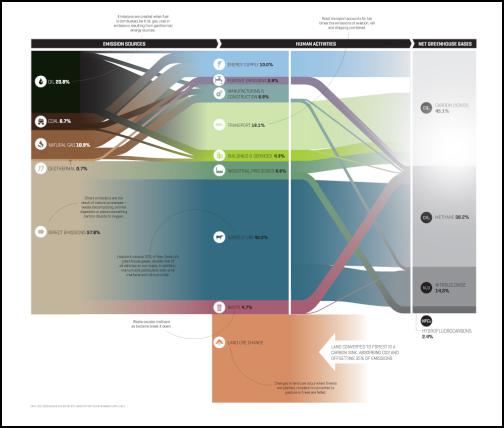May/June issue: NZ Emmission Profile Infographic

Click for bigger version.
FULL SIZE version [pdf]
Hot Air
The first complete picture of New Zealand’s emissions, from source to sky.
Drawing on new data from the Ministry for the Environment's Greenhouse Gas Inventory published in April, New Zealand Geographic magazine has produced the first comprehensive infographic illustrating New Zealand's emissions, from fuel source to greenhouse gases emitted.
Greenhouse gases are emitted when fossil fuels are combusted or as the result of natural processes such as decomposition and digestion. Every country has a different emissions profile, depending on the mix of industries, energy supply, transport infrastructure and land use. And changes to any of these factors year to year change how much greenhouse gas is produced or absorbed.
Over 2012, New Zealand’s net greenhouse-gas emissions rose by 26.1 million tonnes, a 111.4 per cent increase on the levels in 1990 when New Zealand became a signatory to the Kyoto Protocol, which sets standards for carbon accounting. Under it, changes such as planting forests—which absorb carbon dioxide—can offset practices which emit carbon dioxide, such as driving a car.
Aotearoa has an emissions profile unlike any other nation, in that just under half of our gases come from farm stock and practices (the global average is just 12 per cent). During 2012, agriculture emitted 35 million tonnes of greenhouse gases, or 46 per cent of total emissions. Most of those were methane, belched into the atmosphere by sheep and cattle as a waste product of digestion. But farming’s impact is greater than the numbers suggest: methane traps 21 times more heat than carbon dioxide over a century. The rest was largely nitrous oxide, 310 times more potent and the bane of ozone to boot. Methane and nitrous oxide together make up 52.5 per cent of New Zealand emissions, against a global average of around 20 per cent.
However, drawing a large proportion of power from renewable hydro generators means that the carbon footprint for New Zealand’s energy sector is less than many other countries’ footprints, at least in some years—a dry year in 2012 forced hydro generators to resort to thermal backup, driving energy emissions up by 900,000 tonnes.
Forestry planting and harvesting can make or break the national greenhouse-gas budget. Trees remove and store carbon from the atmosphere until they’re felled, after which they release it again to become a net liability.
New Zealanders emit around 0.15 per cent of the world’s total greenhouse gases, but that’s enough to make us the fifth-highest-polluting nation per capita among Kyoto’s 40 Annex 1 countries. In 2011, each New Zealander, on average, emitted 16.6 tonnes (CO2-e) into the atmosphere—a figure that can be reduced only by limiting emissions or absorbing more carbon dioxide, emissions that must be curbed in order to avoid dangerous climate change.
The May/June issue of New Zealand Geographic highlights new science that indicates previous climate change projections may have woefully under-estimated the effects of the West Antarctic Ice Sheet. With the rapid increase in greenhouse gases, and the resulting warming, the ice sheet could be near total collapse, raising sea levels by more than two metres, on top of the one metre already predicted.
ENDS


 NZ Trucking Association: TruckSafe New Zealand Launches | A Game-Changer For Heavy Vehicle Safety And Compliance
NZ Trucking Association: TruckSafe New Zealand Launches | A Game-Changer For Heavy Vehicle Safety And Compliance Gaurav Mittal, IMI: How Can We Balance AI’s Potential And Ethical Challenges?
Gaurav Mittal, IMI: How Can We Balance AI’s Potential And Ethical Challenges? Science Media Centre: Several US-based Environmental Science Databases To Be Taken Down – Expert Reaction
Science Media Centre: Several US-based Environmental Science Databases To Be Taken Down – Expert Reaction Consumer NZ: Despite Low Confidence In Government Efforts, People Want Urgent Action To Lower Grocery Bills
Consumer NZ: Despite Low Confidence In Government Efforts, People Want Urgent Action To Lower Grocery Bills NZ Banking Association: Banks Step Up Customer Scam Protections And Compensation
NZ Banking Association: Banks Step Up Customer Scam Protections And Compensation The Reserve Bank of New Zealand: CoFR Seeking Feedback On Access To Basic Transaction Accounts
The Reserve Bank of New Zealand: CoFR Seeking Feedback On Access To Basic Transaction Accounts



